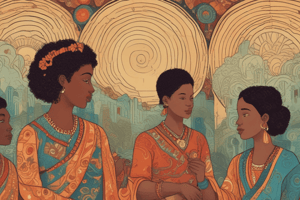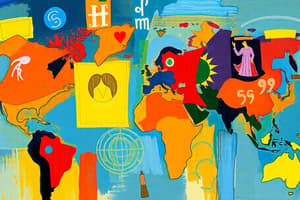Podcast
Questions and Answers
Match the following aspects with their definitions:
Match the following aspects with their definitions:
Cultural Diversity (CD) = The variety of human groups, societies, or cultures in a specific region, or in the world as a whole Cultural Dimensions = Differences in perceptions, knowledge, values, institutions, etc. Multiculturalism = Evolution of societies towards embracing diversity and multiple cultures Globalization = The variety or multiformity of human social structures, belief systems, and strategies for adapting to situations in different parts of the world
Match the following sections with their content:
Match the following sections with their content:
Cultural Diversity Management = Recommendations Cultural Diversity = What is CD
Match the following countries with their examples of increasing cultural diversity:
Match the following countries with their examples of increasing cultural diversity:
USA = Increasing cultural diversity in population France = Increasing cultural diversity in population Germany = Evolution towards multiculturalism Societies worldwide = Evolution towards multiculturalism
Match the following terms with their descriptions:
Match the following terms with their descriptions:
Match the following cultural diversity terms with their definitions:
Match the following cultural diversity terms with their definitions:
Match the following societal culture components with their respective descriptions:
Match the following societal culture components with their respective descriptions:
Match the following management considerations with their implications for organizations:
Match the following management considerations with their implications for organizations:
Match the following societal values dimensions with their characteristics:
Match the following societal values dimensions with their characteristics:
Match the following organizational culture components with their influences:
Match the following organizational culture components with their influences:
Match the following management roles with their responsibilities:
Match the following management roles with their responsibilities:
Flashcards are hidden until you start studying
Study Notes
- Cultural Diversity (CD) is the variety of human groups, societies, or cultures within a community, organization or nation, encompassing differences in race, ethnicity, nationality, religion, or language.
- CD is currently gaining importance due to its significant implications for management of organizations and strategy creation.
- CD can be both a threat and an opportunity, with cultural preservation influencing economic differences and inequalities.
- Organizational culture is influenced by societal culture and is essential for effective management of workstyle expectations, ethics, and attitudes.
- CD Management involves managing cultural differences in personal relations, workplaces, and business partners, allowing for more effective responses to the external environment.
- Organizational culture is shaped by societal culture, including economic/technological setting, political/legal setting, and ethnic background.
- Societal culture is characterized by customs, language, personal values/ethics, and attitudes.
- Managers play a crucial role in managing CD, including choosing the right people for the right tasks and managing attitudes to innovation, learning, failure, success, teamwork, and performance.
- CD within organizations can lead to more effective responses to the external environment, such as globalization and increasing CD in general.
- Careful consideration is required when dealing with cultural hybridization and assumptions about cultural differences.
Studying That Suits You
Use AI to generate personalized quizzes and flashcards to suit your learning preferences.




